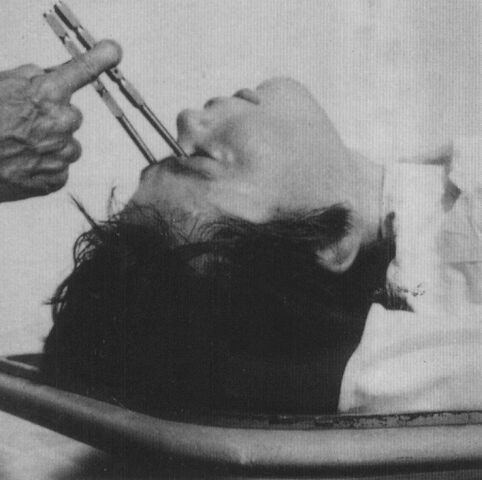neuromorphogenesis:The Surprising History of the LobotomyToday, the word “lobotomy” is rarely mentio
neuromorphogenesis:The Surprising History of the LobotomyToday, the word “lobotomy” is rarely mentioned. If it is, it’s usually the butt of a joke.But in the 20th century, a lobotomy became a legitimate alternative treatment for serious mental illness, such as schizophrenia and severe depression. Physicians even used it to treat chronic or severe pain and backaches. (As you’ll learn below, in some cases, there was no compelling reason for the surgery at all.) There’s a surprising history of the lobotomy for its use in mental health.A lobotomy wasn’t some primitive procedure of the early 1900s. In fact, an article in Wired magazine states that lobotomies were performed “well into the 1980s” in the “United States, Britain, Scandinavia and several western European countries.”The BeginningIn 1935, Portuguese neurologist Antonio Egas Moniz performed a brain operation he called “leucotomy” in a Lisbon hospital. This was the first-ever modern leucotomy to treat mental illness, which involved drilling holes in his patient’s skull to access the brain. For this work, Moniz received the Nobel Prize in medicine in 1949.The idea that mental health could be improved by psychosurgery originated from Swiss neurologist Gottlieb Burckhardt. He operated on six patients with schizophrenia and reported a 50 percent success rate, meaning the patients appeared to calm down. Interestingly, Burckhardt’s colleagues harshly criticized his work at the time.The Lobotomy in America In 1936, psychiatrist Walter Freeman and another neurosurgeon performed the first U.S. prefrontal lobotomy on a Kansas housewife. (Freeman renamed it “lobotomy.”)Freeman believed that an overload of emotions led to mental illness and “that cutting certain nerves in the brain could eliminate excess emotion and stabilize a personality,” according to a National Public Radio article.He wanted to find a more efficient way to perform the procedure without drilling into a person’s head like Moniz did. So he created the 10-minute transorbital lobotomy (known as the “ice-pick” lobotomy), which was first performed at his Washington, D.C. office on January 17, 1946.(Freeman would go on to perform about 2,500 lobotomies. Known as a showman, he once performed 25 lobotomies in one day. To shock his audiences, he also liked to insert picks in both eyes simultaneously.)According to the NPR article, the procedure went as follows:“As those who watched the procedure described it, a patient would be rendered unconscious by electroshock. Freeman would then take a sharp ice pick-like instrument, insert it above the patient’s eyeball through the orbit of the eye, into the frontal lobes of the brain, moving the instrument back and forth. Then he would do the same thing on the other side of the face.”Freeman’s ice-pick lobotomy became wildly popular. The main reason is that people were desperate for treatments for serious mental illness. This was a time before antipsychotic medication, and mental asylums were overcrowded, Dr. Elliot Valenstein, author of Great and Desperate Cures, which recounts the history of lobotomies, told NPR.“There were some very unpleasant results, very tragic results and some excellent results and a lot in between,” he said.Lobotomies weren’t just for adults either. One of the youngest patients was a 12-year-old boy! NPR interviewed Howard Dully in 2006 at the age of 56. At the time, he was working as a bus driver.Dully told NPR:“If you saw me you’d never know I’d had a lobotomy,” Dully says. “The only thing you’d notice is that I’m very tall and weigh about 350 pounds. But I’ve always felt different — wondered if something’s missing from my soul. I have no memory of the operation, and never had the courage to ask my family about it…”The reason for Dully’s lobotomy? His stepmother, Lou, said Dully was defiant, daydreamed and even objected to going to bed. If this sounds like a typical 12-year-old boy, that’s because he was. According to Dully’s father, Lou took her stepson to several doctors, who said there was nothing wrong with Dully, and he was just “a normal boy.”But Freeman agreed to perform the lobotomy. You can check out the NPR article for Freeman’s notes on Dully and more from his patients’ families. (There’s also lots more on lobotomies on their website.)The EndIn 1967, Freeman performed his last lobotomy before being banned from operating. Why the ban? After he performed the third lobotomy on a longtime patient of his, she developed a brain hemorrhage and passed away.The U.S. performed more lobotomies than any other country, according to the Wired article. Sources vary on the exact number but it’s between 40,000 and 50,000 (the majority taking place between the late 1940s and early 1950s).Curiously, as early as the 1950s, some nations, including Germany and Japan, had outlawed lobotomies. The Soviet Union prohibited the procedure in 1950, stating that it was “contrary to the principles of humanity.” (How ironic.) -- source link
Tumblr Blog : themedicalstate.tumblr.com
#lobotomy

